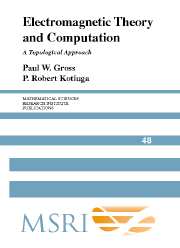Book contents
- Frontmatter
- Table of Contents
- Preface
- Introduction
- 1 From Vector Calculus to Algebraic Topology
- 2 Quasistatic Electromagnetic Fields
- 3 Duality Theorems for Manifolds With Boundary
- 4 The Finite Element Method and Data Structures
- 5 Computing Eddy Currents on Thin Conductors with Scalar Potentials
- 6 An Algorithm to Make Cuts for Magnetic Scalar Potentials
- 7 A Paradigm Problem
- Mathematical Appendix: Manifolds, Differential Forms, Cohomology, Riemannian Structures
- Bibliography
- Summary of Notation
- Examples and Tables
- Index
Introduction
Published online by Cambridge University Press: 06 July 2010
- Frontmatter
- Table of Contents
- Preface
- Introduction
- 1 From Vector Calculus to Algebraic Topology
- 2 Quasistatic Electromagnetic Fields
- 3 Duality Theorems for Manifolds With Boundary
- 4 The Finite Element Method and Data Structures
- 5 Computing Eddy Currents on Thin Conductors with Scalar Potentials
- 6 An Algorithm to Make Cuts for Magnetic Scalar Potentials
- 7 A Paradigm Problem
- Mathematical Appendix: Manifolds, Differential Forms, Cohomology, Riemannian Structures
- Bibliography
- Summary of Notation
- Examples and Tables
- Index
Summary
The title of this book makes clear that we are after connections between electromagnetics, computation and topology. However, connections between these three fields can mean different things to different people. For a modern engineer, computational electromagnetics is a well-defined term and topology seems to be a novel aspect. To this modern engineer, discretization methods for Maxwell's equations, finite element methods, numerical linear algebra and data structures are all part of the modern toolkit for effective design and topology seems to have taken a back seat. On the other hand, to an engineer from a half-century ago, the connection between electromagnetic theory and topology would be considered “obvious” by considering Kirchhoff's laws and circuit theory in the light of Maxwell's electromagnetic theory. To this older electrical engineer, topology would be considered part of the engineer's art with little connection to computation beyond what Maxwell and Kirchhoff would have regarded as computation. A mathematician could snicker at the two engineers and proclaim that all is trivial once one gets to the bottom of algebraic topology. Indeed the present book can be regarded as a logical consequence for computational electromagnetism of Eilenberg and Steenrod's Foundations of Algebraic Topology [ES52], Whitney's Geometric Integration Theory [Whi57] and some differential topology. Of course, this would not daunt the older engineer who accomplished his task before mathematicians and philosophers came in to lay the foundations.
The three points of view described above expose connections between pairs of each of the three fields, so it is natural to ask why it is important to put all three together in one book.
Information
- Type
- Chapter
- Information
- Electromagnetic Theory and ComputationA Topological Approach, pp. 1 - 6Publisher: Cambridge University PressPrint publication year: 2004
Accessibility standard: Unknown
Why this information is here
This section outlines the accessibility features of this content - including support for screen readers, full keyboard navigation and high-contrast display options. This may not be relevant for you.Accessibility Information
- 1
- Cited by
